The biggest hurdle for lawyers with disabilities: preconceptions
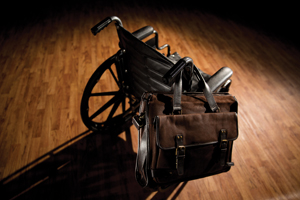
Photo by Wayne Slezak
"I finally convinced her that she was digging a hole she'd never get out of if she didn't come forward," Brittain says. "It was hurting her career."
Brittain is a prominent management-side employment litigator in the 400-lawyer firm, but the slight irony ends there. After he had become established in his field, Brittain suffered serious problems related to the late onset of Type 1 diabetes. He underwent a radical surgical procedure in 1995 to stop hemorrhaging in his eyes, which left him with limited vision, he says, “like looking out an airplane window going through a cloud.” Six years later, he lost his left leg below the knee and grew hard of hearing.
Years ago the firm began accommodating Brittain, 67, a rainmaker who among other things needs a driver and can read only large print. So the associate went to him with her problem.
“I was able to approach the powers that be and say the strikes against her work aren’t right,” he says. “I told them she’s a very bright lawyer and we need to deal with her ADD differently than we do with other lawyers.”
The solution: Break assignments into pieces so as not to overwhelm her. Rather than task her with drafting a brief in two weeks, ask for a statement of facts in three days; then a research memo; and finally a statement of law. It worked.
“There is a stigma attached to something when people really don’t know much about it—in this instance, mental disabilities,” says Brittain, who recently lost his other leg. “Getting them to come forward is the biggest issue.”
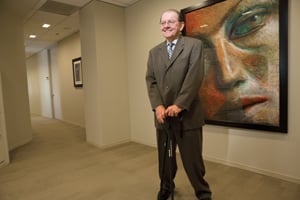
Max Brittain is a senior partner and litigator at Schiff Hardin. Photo by Wayne Slezak.
A RARE PRESENCE
Brittain’s own disabilities, particularly in combination, are still a rare presence at big law firms, or any firm for that matter—and obviously Schiff Hardin’s willingness to increase accommodations for him stems at least in part from his proven ability, before and after his disabilities, to bring in work and get it done.
Many lawyers with disabilities still end up where they always were: channeled toward government work, advocacy organizations or solo and small-firm employment, often with disability-related practices.
Over the past couple of decades, technological and medical advances have made it much easier (or in some instances, possible) for lawyers with disabilities to perform ordinary tasks in legal work. There are devices and software that read digital documents to the blind, refreshable Braille machines that can provide real-time communication, and instant transcripts on computer screens for the deaf—even in court hearings with direct feeds from stenographers.
But at the same time, old attitudes and perceptions have been slow to lose their grasp.
“We’re still often looked at as a delicate flower or damaged, and that makes it hard to be part of the diverse fabric of the workforce,” says Stuart Pixley, a senior attorney at Microsoft Corp. in Redmond, Washington, specializing in patent licensing transactions.
Pixley formerly worked in three big law firms, including a partnership at the megafirm Baker & McKenzie. He has cerebral palsy and uses an electric wheelchair and hearing aids.
Though he succeeded in law practice, Pixley felt isolated and discouraged in the firms. “I don’t remember seeing anyone who looked like me.” Pixley adds that Microsoft is so systematically intensive about building “an understanding of disabilities through cultural competence” rather than through gestures of political correctness, that “I have an idyllic world here.”
The unintended marginalization in big firms was as simple as a social function. As a summer associate in New York City at Milbank, Tweed, Hadley & McCloy in the mid-1990s, for example, Pixley wasn’t asked how he might negotiate the 2 miles from the office to a cocktail party at a Mexican restaurant in SoHo. The firm, where he later would work full time for two years as an associate, rented a yellow school bus to pick him up and drop him off.
“It came late and eventually I showed up when a few people were still there,” Pixley says of the transportation spectacle. “But there I was in a suit and getting off a school bus at a law firm function. They didn’t know exactly how to get me there and were reluctant to say ‘take a public bus,’ which they probably should have done.”
Other, more problematic misunderstandings hurt his acceptance as a team member, even as a partner. Pixley once was asked at a large gathering by a partner—a friend—how well the hearing aids helped him. Not great in such a setting, but not bad when using the telephone, he replied, which is how a lot of communication with clients is done.
“I told him I ask them to repeat things now and then, and that my theory is to be light-handed and comfortable with that,” Pixley recalls. “But then [some in the firm] became afraid that if I let folks know I have a hearing impairment and asked them to repeat themselves too many times, that they might literally fear being double-billed.”
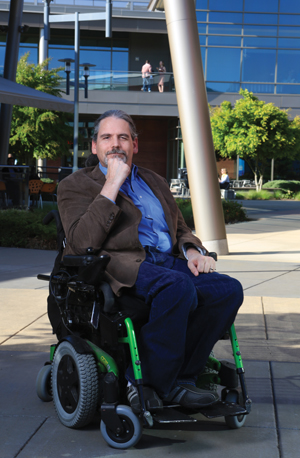
A senior attorney at Microsoft, Stuart Pixley specializes in patent licensing transactions. Photo by Chris Joseph Kalinko.
UNKNOWN NUMBERS
The number of lawyers with disabilities is hard to determine. Unlike race, gender, ethnicity and, more recently, sexual orientation, there is little reporting on them. Only two state bars—those in Oregon and Washington—have done tallies, and still that is self-reporting. Some lawyers won’t do so; some others don’t see themselves as disabled. And the definition of disability under the Americans with Disabilities Act is fast expanding, largely via the hottest area: mental health impairments.
In an ABA membership survey in 2013, 8 percent of the lawyers answered in the affirmative when asked whether they have disabilities. A 2012 survey by the Washington State Bar Association found that 21 percent of its members said so. The National Association for Law Placement found that just one-third of 1 percent of law firm partners reported having disabilities in its 2014 survey, which was slightly higher than a few years earlier. Associates with disabilities composed just 0.28 percent, also slightly higher than before. The figures were based on data from 740 law offices and firms (including some reporting zero disabilities) encompassing 73,081 lawyers.
Whatever the totals, they are increasing, as is the number of law students seeking accommodations for disabilities. Many of them have been coming together in a disability rights movement, including solo practitioners who represent others in accessibility cases under the ADA, law firms and advocacy groups specializing in disability law, and law firm lawyers who work pro bono.
The networking in those efforts has led to an increase in organized bar groups, such as the Disability Rights Bar Association, launched in 2006 by abled and disabled lawyers, academics, and nonprofit law and disability advocacy groups; the recently formed National Association of Attorneys with Disabilities; and the National Association of Law Students with Disabilities, started in 2007 with help from the ABA’s Individual Rights and Responsibilities Section.
‘WE’RE FIGHTING BACK’
“The ADA has been in effect since 1990, and people with disabilities are fed up with so much failure to follow it,” says William Goren, who is passionately outspoken and whose solo practice based in Decatur, Georgia, is built around advising companies and litigants on the ADA and other disability law topics. “So we’re not as willing to get rolled as we used to be. We’re fighting back.”
Goren, 54, is deaf, but uses powerful hearing aids that lessen his hearing loss to only 40 percent; thus, functionally, he is considered hard of hearing. In his 30s, Goren developed debilitating joint problems and is unable to use a computer keyboard or mouse.
“I can’t use a computer without voice dictation,” he says. “And I can’t tell you how many software programs I’ve bought that turned out not to be accessible with voice-dictation technology.”
Goren is a prolific writer of books and scholarly articles, as well as on his blog Understanding the Americans with Disabilities Act, which made the ABA Journal’s Blawg 100 for 2014. His authoritative book of the same name, published by the ABA, is in its fourth edition.
Goren founded the National Association of Attorneys with Disabilities in 2013 along with seven other executive board members, including Pixley of Microsoft. (Pixley also is one of 15 appointed members of the ABA Commission on Disability Rights, which collaborates with many organizations.) The NAAD, just finishing its organizational and structural stage, is a cross-disability group for developing a national voice in matters of accessibility and other civil rights, as well as pushing for inclusion in diversity efforts in the judiciary and elsewhere.
Something of a critical mass has formed to press for disability rights in general. In recent years there has been a cascade of incremental progress, such as rulings or agreements concerning the likes of Netflix (closed-captioning for the deaf), eBay and Target (website access for the blind), and Scribd (see “Sites for Sore Eyes,” February, page 15).
“I’m primarily dealing with the digital version of no wheelchair ramp,” says Tim Elder, a Fremont, California, lawyer who is blind and has a solo practice focused on the intersection of technology and disability rights law, especially concerning startup companies and innovative technology.
“We’re moving toward a more virtual workspace, and rather than focus on reasonable accommodations, we need to take the same approach as with physical buildings and think about how we’re designing this virtual space.”
It is much easier to build accessibility into software when it is developed than later, much like putting an elevator in a 20-story building during its construction rather than afterward.
Elder, 35, is involved in litigation nationwide, with cases including Marriott hotels’ use of enterprise software inaccessible to the blind and Uber car service, whose drivers sometimes refuse to take service animals.
He is one of an increasing number of lawyers with disabilities who are active in leadership positions in the organized bar. Elder came up through the ABA’s Young Lawyers Division and—in a significant gain for the disability rights movement—is a member of the ABA’s Standing Committee on Technology and Information Systems, which deals with accessibility, among other issues.
More than once, Elder says, he has been recruited to work ADA cases on the defense side. “I have no problem working with management if they’re trying to do the right thing, but this is more fulfilling and frankly more interesting substantively for me. And I have more work to do than bandwidth to do it.”
The practice area is white-hot.
Since he began teaching disability law a dozen years ago, Michael Waterstone has seen a huge increase in numbers of students—abled and disabled—who come to him interested in such a practice.
“This is a growing area with a lot of legal work for both sides, plaintiff and defendant,” says Waterstone, now at the Loyola School of Law in Los Angeles. “It’s reached the point where I increasingly tell law students with disabilities that if they want to make it their life’s work, fine, but don’t feel like you need to do it.”
In fact, Waterstone sees an even greater need for lawyers with disabilities to enter and rise to the top levels of major law firms.
Waterstone’s mentor when he was an associate at the Los Angeles-based litigation powerhouse Munger, Tolles & Olson was the late Charles Siegal, who wore leg braces as a result of polio and did pro bono work on disability rights matters.
“I was able to see how he could do more in some ways for the movement than a lawyer similarly situated doing strictly public interest work,” Waterstone says. “Because of who he was, he could call people in positions of power and get them interested in disability issues.”
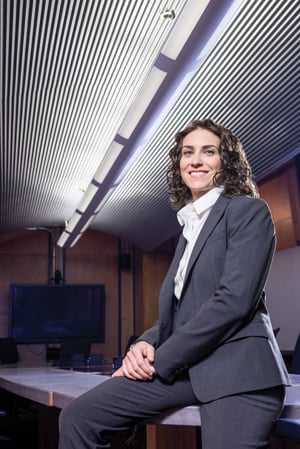
The Washington, D.C., municipal government now includes closed-captioning in videos posted on its website, thanks to the pro bono efforts of deaf law partner Melissa Felder Zappala. Photo by David Fonda.
EARLY LOSSES
For many years ADA cases did not fare well in the courts, with the tone set at the top of the federal judiciary: Four appeals made it to the U.S. Supreme Court, which saw none that it liked. In fact, Congress passed the Americans with Disabilities Amendments Act in 2008 expressly to overturn two of those cases that had narrowed the scope of what qualifies as a disability under the ADA.
Hundreds of cases brought after the amendments went into effect in 2009 are now working their ways through the courts. Many fewer plaintiffs are losing summary judgment motions on the definitions of disability and whether they are disabled; more substantive issues are now being thrashed out. Judges are delving into such issues as whether plaintiffs are capable of doing the job with accommodation or whether such accommodation puts undue hardship on the employer, according to Stephen Befort, a University of Minnesota Law School professor who did an empirical study of ADA cases between January 2010 and April 2013.
“Over the next few years we’re going to see some pivotal decisions,” says Waterstone, the Loyola law professor.
Some critics have complained that disability rights litigation is too diffuse, that there is need for greater coordination and focus so as to produce an equivalent of the very carefully orchestrated Brown v. Board of Education case, the 1954 Supreme Court ruling that ended racial segregation in public schools.
“But I have a hard time counting to five for a pro-disability rights decision,” says Daniel Goldstein of Baltimore’s Brown, Goldstein & Levy, alluding to the current makeup of the high court. “So why not design something with the intent to get results at the federal circuit court level?”
Goldstein, a member of the ABA’s Commission on Disability Rights and founder in 2006 of what now is the Disability Rights Bar Association, argued such a case at the 4th U.S. Circuit Court of Appeals at Richmond, Virginia, in February. In Reyazuddin v. Montgomery County, he challenged a Maryland county government’s purchase of an enterprise software system that is inaccessible to the blind and thus makes them unemployable.
A lot of cases are brought simply because a problem exists and someone takes an interest. Melissa Felder Zappala, a deaf partner in the Washington, D.C., office of the talent-magnet litigation and corporate firm Boies, Schiller & Flexner, recently worked pro bono on a lawsuit against the D.C. government for posting videos that lacked closed-captioning on its website. She brought in her father, Barry Felder, a litigation partner at Foley & Lardner in New York City, to join forces with the Washington Lawyers’ Committee for Civil Rights and Urban Affairs. The city settled, agreeing to use captioning going forward.
After her first year at Georgetown University Law Center, Zappala interned at the National Association of the Deaf’s Law and Advocacy Center and became interested in a career in disability law. The following year, as a summer associate at Boies Schiller, she grew fond of analyzing complex commercial litigation matters well enough to box in the other side.
“I prefer to do disability rights pro bono,” says Zappala, who speaks on phone calls and can read the other person’s responses immediately, via a third-party service, on her office computer screen. She can usually also hear the other person thanks to a cochlear implant and residual hearing. Zappala gets similar readouts on a computer screen at depositions and court hearings, though it is largely backup because she also reads lips.
The implant, done on her worst ear, was a gamble Zappala took between law school and coming to the firm. Had it failed, she might have lost all hearing in that ear.
Waterstone welcomes efforts such as Zappala’s but believes a long-term, big-case strategy still is needed. He says states like Connecticut have constitutional equal-protection clauses that go beyond what is available in the federal system, providing heightened scrutiny in disability matters.
“I would like to see more aggressive activity pushing the bounds of favorable state law,” says Waterstone, “and over time set precedent that a more rigorous review of state laws that draw lines on the basis of disability is not such a terrible thing.”
Even if there were such a forward-looking approach, as the ADA hits its 25th anniversary this year, the old brick-and-mortar battles continue. While Elder says he’s dealing now with the digital version of curb ramps, problems remain real where wheelchair rubber meets those curbs.
“We could go to almost any city and I guarantee I could find, within 1 square mile, 15 corners in violation,” says Tim Fox, a Denver lawyer who in 1986 was paralyzed from the shoulders down while playing rugby in college. “The cities still weren’t paying attention after the ADA was passed.”
Fox was in his second year at Stanford Law School when the legislation went into effect in 1990. Later he and his wife, Amy Robertson, whom he met when they were associates at what now is Wilmer Cutler Pickering Hale & Dorr in D.C., opened a litigation firm in Denver specializing in disability rights cases. In 2013 they folded Fox & Robertson and launched the Civil Rights Education and Enforcement Center. Still litigating, they added flexibility for efforts such as educational presentations for advocacy groups.
CREEC is now in negotiations with three cities, all with populations greater than 1 million, to make curbs accessible.
A NEW ISSUE: THE BRAIN
The fastest-expanding and sharpest-edged issue for diversity in the legal profession concerns mental disabilities, such as ADD, bipolar disorder and depression. Lawyers are 3.6 times more likely than others to suffer depression, according to a 1990 Johns Hopkins University study.
Even as more employers recruit lawyers with sight, hearing and mobility problems, they still recoil at dealing with what they see as unknowable possibilities of a disabled mind. The fact that these impairments are often treatable and manageable is overshadowed by social stigma and lack of understanding.
The U.S. Department of Justice recently has drawn some bright lines to sort fact from surmise.
Last August the DOJ announced a settlement with the Louisiana Supreme Court, which agreed to stop asking bar applicants, in violation of the ADA, about mental health diagnosis and treatment. Now the court will seek such information only when there is evidence of a problem that affects the applicant’s competency, ethics or professional manner. The court also agreed to pay $200,000 to some bar applicants and lawyers. Justice has its eye on similar issues in Connecticut and Vermont.
A few months earlier, the Law School Admission Council settled with the DOJ, which had intervened in a class action alleging that LSAC accommodations for the disabled were denied routinely for the Law School Admission Test, and that the council flagged the test scores of those who were accommodated so law schools would know they had been given extra time.
Under the settlement, the LSAC agreed to streamline and professionalize review of accommodation requests and cease flagging of scores. Without admitting liability, the council agreed to pay $7.73 million.
“The interesting paradox is that there are lots of high-incidence conditions protected by the ADA that are not visible or obvious,” says Andrew Imparato, who is up front about his periodic depression and has done high-level policy work on mental health issues, including three years as senior counsel and disability policy director for U.S. Sen. Tom Harkin, D.-Iowa, when Harkin chaired the Committee on Health, Education, Labor and Pensions. “Depression, anxiety and obsessive compulsive disorder are three common characteristics that exist in every law firm.”
But when a lawyer with one or more of those difficulties comes out about it, many firms are quick to worry about client perceptions.
“The reality is that firms are dealing with this whether it’s in the open or not,” says Imparato, now executive director of the Association of University Centers on Disabilities. “If high-level people start talking openly about depression or whatever, it changes the culture.”
Imparato suffered his first serious episode of depression in his final semester at Stanford Law School, and he entered the profession adjusting to a new diagnosis of being bipolar. He immediately went into public-interest work in disability law, which made it easier to be open from the start.
His impairment is predictable. Imparato’s energy and self-confidence diminish for about five or six months each year, and his method for dealing with it might bring a smile to a hiring partner: “I try to stay busy. My worst days are when I don’t have enough to do.”
FUNDAMENTAL SHIFT
Attitudes and perceptions have long been the fly in most ointments. And a fundamental shift is underway as some law firms, such as Schiff Hardin, take the lead in considering lawyers with disabilities as a minority group—not as people deserving pity or charity. As with other groups, individuals range from the mediocre to the superstar in a profession whose core requirements are knowledge, analytical skill and judgment.
At Brittain’s request a few years ago, his firm (as do a handful of others) has a so-called affinity group for lawyers with disabilities among its various diversity efforts, along with those for race, gender and ethnicity.
The dearth of individuals with disabilities in the legal profession prompted the ABA Commission on Disability Rights in 2009 to proffer a pledge for committing to support disability rights. It is titled Disability Diversity in the Legal Profession: A Pledge for Change (PDF). It is a commitment to help ensure that lawyers with disabilities are given a fair chance at work in the profession, and to better reflect the diversity of communities, clients and customers. The more than 175 signatories thus far include law firms, law schools, corporations, organized bar groups and others.
When a lawyer with a disability applies for a job, too often the first question concerns what he or she can’t do, rather than what they can.
“I don’t think we talk enough about enabling excellence, enabling people to bring their A game,” Pixley says. “I want to bring my A game.”
This article originally appeared in the June 2015 issue of the ABA Journal with this headline: “Able: The biggest hurdle for lawyers with disabilities: preconceptions.”
Sidebar
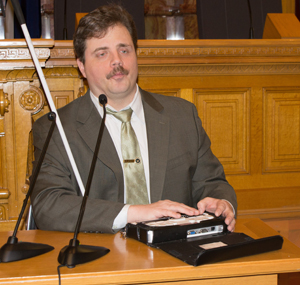
Scott LaBarre says that creating searchable PDF text is not difficult, expensive or too much to ask. Photo courtesy of Scott LaBarre.
A PDF Battle Won
In late 2002, then-61-year-old Tom Ross had minor abdominal surgery that was botched and left him blind from sepsis. It was four months before he regained consciousness and three years before he could resume his commercial real estate transactions practice at the 600-lawyer firm Akerman.After retiring in 2009, Ross, who had only occasionally ventured into courtrooms over four decades, represented a friend, also a real estate lawyer, in a suit against Windermere, Florida, a small town in suburban Orlando, over drainage problems.
Ross was incensed that documents produced by the judge and the town's lawyers often were static-form PDFs—scanned visual images of documents—rather than dynamic PDFs with searchable text. When he ran the digital files through the screen reader on his computer, which can turn text into speech, it told him nothing was there.
His repeated complaints to the judge and clerk of the Orange County circuit court were unavailing. Opposing counsel gave him no quarter.
"At the end of my career and trying to help someone, not making any money on it, and dealing with a bunch of Neanderthals who haven't got the professional courtesy to be decent, it just pissed me off," says Ross, speaking of opposing counsel.
Well-known in his field, resourceful and persistent, Ross complained to the U.S. Department of Justice. Against the odds, it acted: Last July the DOJ announced a settlement with the Orange County clerk of courts for ADA violations. The court now will provide any document of record in an accessible format and ensure the court's website is accessible to those with disabilities.
Ross got $10,000 for his trouble. The underlying suit had settled: $200,000 in legal fees for Ross; $185,000 in damages for his client. And, Ross estimates, close to $1 million was paid by Windermere and its insurer for their own lawyers. The original request had been for a mere $25,000 fix on the drainage problem.
"My point is that even though I can afford $900 software that could crack those PDFs, it's not fair because not every young lawyer can afford it, and some law firms can't," Ross says.
While the feds came to his rescue in Florida state court, Ross would have no luck if he were to go after the federal judiciary. Federal judges might preside over ADA cases, but they're not subject to the law because it pertains only to state and local employers. But most federal courts present the same problem: The notoriously dull-edge PACER system often provides static PDFs that are inaccessible to the blind.
Creating PDFs that have searchable text is not difficult, not expensive and not too much to ask, says Scott LaBarre, a Denver lawyer who is blind and is a former chair of the ABA Commission on Disability Rights.
"The expectation is that everything now is born digital; and if it is, we ought to have a way to get at it through screen readers or other devices," LaBarre says. "I have some tools to deploy and can ask my secretary to run it through software to make it accessible, but that takes time, and time is money."
The Administrative Office of the U.S. Courts has no standards for PDFs, but is working to improve accessibility for blind users as it develops NextGen, the next generation version of case management/electronic case files software, a spokesman says.
Early adopters of NextGen, the 2nd and 9th U.S. circuit courts of appeal at New York City and San Francisco, respectively, now require text-searchable PDFs, except for attached exhibits.



